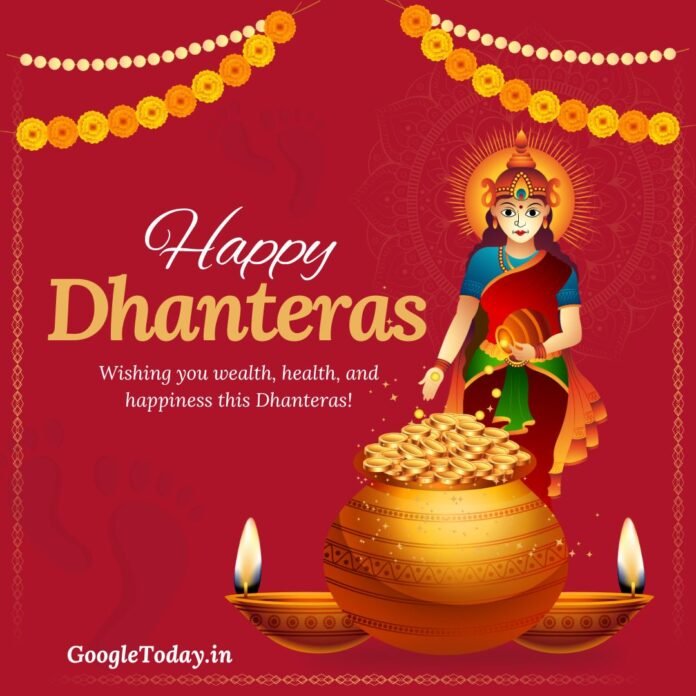Dhanteras, also known as Dhanatrayodashi, marks the beginning of the five-day-long Diwali festival in India. It falls on the thirteenth lunar day of Krishna Paksha (the dark fortnight) in the month of Ashwin (October-November) according to the Hindu calendar. Derived from the Sanskrit words “Dhan” (meaning wealth) and “Teras” (meaning the thirteenth day), this festival is celebrated with great enthusiasm as a symbol of wealth, prosperity, and well-being.
Dhanteras carries immense significance, especially for businesses, traders, and households. The day is marked by shopping for precious metals like gold and silver and is considered highly auspicious for making new investments. But Dhanteras is more than just material wealth; it is deeply connected with spiritual well-being and the removal of negative energies. In this article, we explore the origin, rituals, cultural significance, and modern-day relevance of Dhanteras in detail. Let us read in detail on GoogleToday.in .
Origin and Mythological Significance
Several fascinating myths and legends are associated with Dhanteras, each highlighting the festival’s connection to prosperity, health, and protection from misfortune.
- The Story of King Hima’s Son :
- According to one popular legend, there was a young prince whose horoscope predicted his death by a snake bite on the fourth day of marriage.
- To prevent this calamity, his newly-wedded wife came up with a clever plan.
- She piled a heap of gold and silver coins, jewels, and lamps at the entrance of their chamber and kept him awake by singing songs and narrating stories throughout the night.
- When Yama, the god of death, arrived in the guise of a serpent, he was blinded by the dazzling light of the treasures and mesmerized by the wife’s devotion.
- Yama sat on the heap of wealth, listening to the songs, and quietly left the next morning, sparing the prince’s life.
- Thus, Dhanteras is also associated with Yamadeepdan, where people light lamps to please Yama and ward off untimely death.
2. Churning of the Ocean – Samudra Manthan :
- Another myth ties Dhanteras to the churning of the ocean (Samudra Manthan) by gods and demons to obtain the nectar of immortality.
- During this event, Dhanvantari, the physician of the gods, emerged with a pot of amrit (nectar) and the sacred Ayurvedic scriptures.
- This event symbolized the origin of health and well-being, making Dhanteras an important day for worshipping both wealth (Lakshmi) and health (Dhanvantari).
Rituals and Traditions of Dhanteras
Dhanteras is celebrated with several meaningful rituals, many of which revolve around worship, shopping, and lighting lamps. Below are the most common traditions associated with the festival:
1. Shopping for Precious Metals and New Items :
- Buying gold, silver, or utensils is a key ritual of Dhanteras, believed to attract good fortune and wealth throughout the year.
- People purchase jewelry, coins, or home appliances, considering it an auspicious time to start new ventures.
- In rural areas, farmers often invest in farming equipment or cattle to bring prosperity to agriculture.
2. Lakshmi Puja :
- In the evening, people perform Lakshmi Puja, invoking the blessings of Goddess Lakshmi, the deity of wealth, for financial stability and prosperity.
- Devotees light clay lamps (diyas) to illuminate the home and dispel darkness, both literal and metaphorical.
- Traditional offerings include sweets, fruits, flowers, rice, and kumkum, which are offered with devotion.
3. Yamadeepdan – Offering to Yama :
- Lamps are lit outside homes throughout the night as an offering to Yama, the god of death, for protection from untimely death.
- Families chant prayers seeking health and longevity for their loved ones, reinforcing the spiritual aspect of the festival.
4. Decorating Homes and Rangoli :
- People clean and decorate their homes with colorful rangolis (patterns made with powdered colors or flowers), symbolizing happiness and joy.
- Torans (decorative door hangings) and marigold garlands are used to beautify entrances, welcoming positive energies.
Spiritual Significance of Dhanteras
While Dhanteras is often viewed through the lens of material prosperity, it carries a deeper spiritual significance:
- Symbol of Abundance: The festival highlights the importance of abundance in all areas of life—wealth, health, happiness, and relationships.
- Gratitude for Blessings: The rituals encourage people to express gratitude for the wealth and comforts they already possess.
- New Beginnings: Dhanteras is considered a time to make positive changes, eliminate negativity, and align with divine energies.
- Wealth as a Responsibility: The festival teaches that wealth should be earned ethically and used for the well-being of others, promoting charity and generosity.
How Dhanteras is Celebrated Across India
Though Dhanteras is widely celebrated across India, there are regional variations in the way the festival is observed:
- North India: The emphasis is on purchasing gold and silver, along with elaborate Lakshmi Puja. In cities like Delhi and Jaipur, bustling markets are filled with shoppers buying jewelry and utensils.
- West India: In Maharashtra and Gujarat, people clean and paint their homes, decorating them with rangolis and lighting numerous lamps. Business communities and traders close their annual accounts and start new ones on this day.
- South India: While Dhanteras is not as prominent in South India, Ayurvedic practitioners and medical institutions observe it as a tribute to Dhanvantari, the deity of health and medicine.
- Rural India: In villages, farmers celebrate by buying cattle and tools for agriculture, expressing their hope for a prosperous harvest.
Dhanteras in Modern Times
With changing lifestyles, the way Dhanteras is celebrated has also evolved:
- E-commerce and Online Shopping: People increasingly turn to online platforms to buy jewelry, utensils, and gadgets, taking advantage of festive discounts.
- Eco-friendly Celebrations: Many households prefer using reusable lamps and eco-friendly decorations to reduce environmental impact.
- Charity and Social Welfare: Some people use this occasion to donate money, food, and clothes to the underprivileged, sharing their wealth with those in need.
- Corporate Celebrations: Companies often give Dhanteras bonuses or gifts to employees, fostering a sense of goodwill and teamwork.
Conclusion
- Dhanteras is more than just a festival of wealth;
- it is a time to celebrate life, health, and new beginnings. Rooted in ancient traditions and spiritual values, the festival emphasizes the importance of gratitude, generosity, and ethical living.
- The rituals associated with Dhanteras—whether it’s buying gold, lighting lamps, or worshiping deities—remind us of the delicate balance between material success and inner contentment.
- As we embrace modernity, the essence of Dhanteras remains relevant, encouraging us to pursue prosperity while staying grounded in values of compassion and well-being.
- Whether celebrated in bustling markets or quiet homes, Dhanteras continues to spread the message of hope, wealth, and happiness, lighting the way to a prosperous future.

